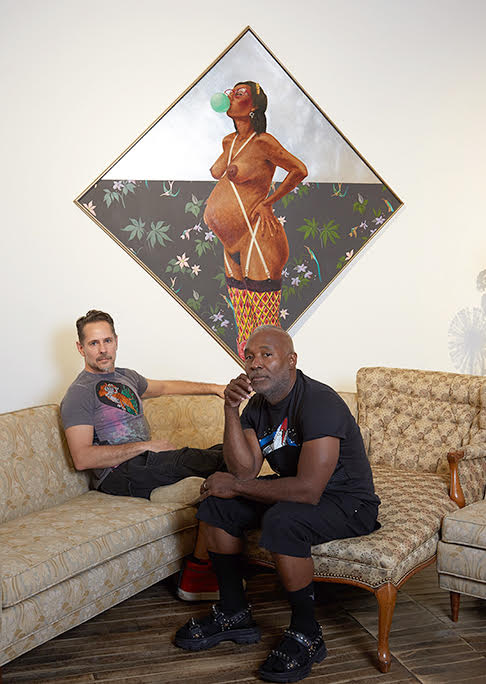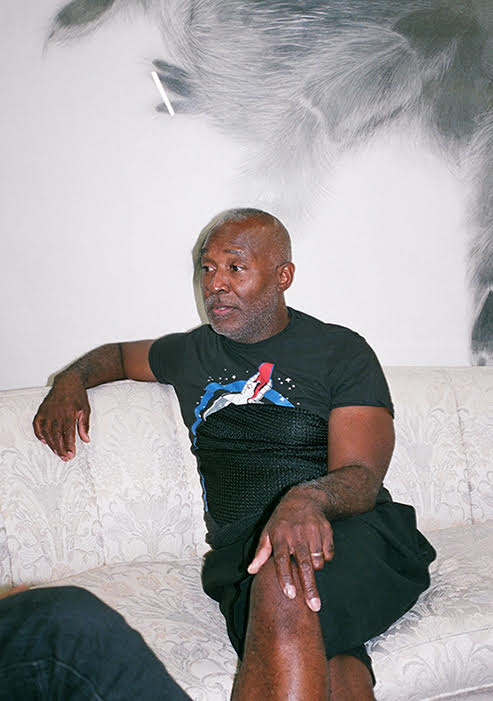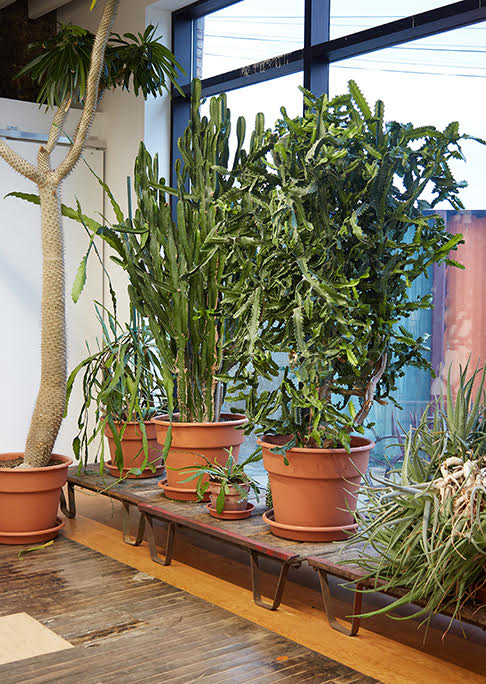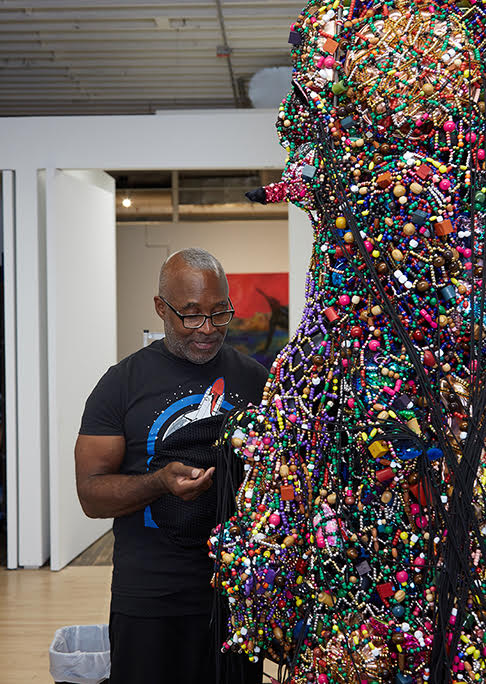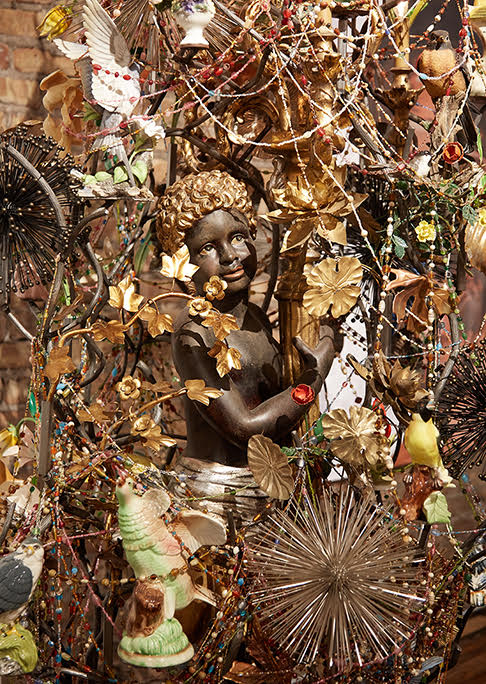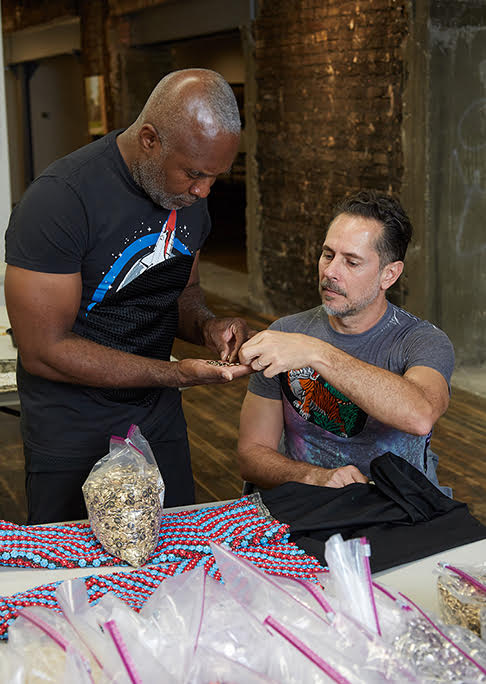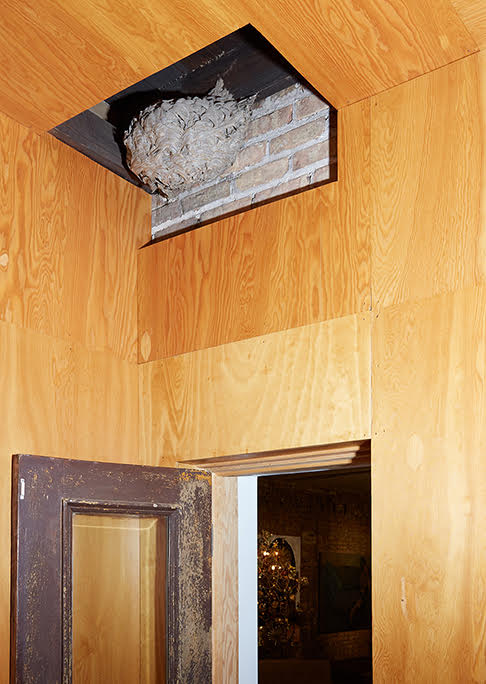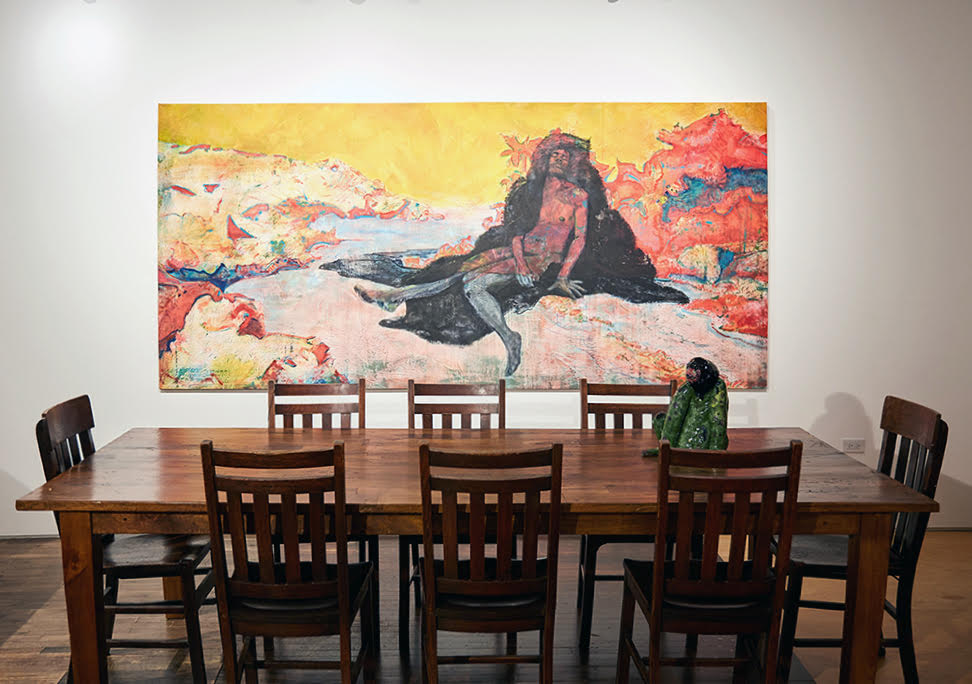NICK CAVE
& BOB FAUST
Interview by Michael Bullock
Photography by Vincent Dilio
Apartamento 25, 2020
In Chicago, on the border between the Old Irving Park and Kilbourn Park neighbourhoods, a 20-minute drive from the Loop, a small, rundown former textile factory, which had been dormant for the past decade, was thoughtfully rebuilt and combined with two adjoining properties. In the fall of 2018, shortly after it was completed, the newly renovated storefront windows were unveiled with giant text that boldly proclaimed: ‘Love Thy Neighbor’. With this statement, the building reopened and Facilitywas born. Created by the artist Nick Cave and designer Bob Faust, the new complex is home to a range of enterprises: Cave Studio, Faust Studio, and the partners’ joint ventures, Soundsuit Shop and the Facility Foundation. While the building’s first floor was designed to streamline their work, a fast-paced production of interdisciplinary collaborations, art-making, and public programs, the second floor is its zen counterbalance: sparse, gallery-inspired living quarters where the non-stop couple can unwind and appreciate the work of other artists. Their prized personal collection is made up of Cave’s colleagues and former students.
Since the ‘90s, Cave and Faust have collaborated on everything from books and exhibitions to products and performances. In this time, Cave has gained worldwide acclaim as the inventor of the Soundsuit, an inventive hybrid of sculpture, fashion, and performance that began as an intuitive response to the Rodney King incident and the LA riots. In the past few years Cave has used his stature to experiment with social-practice concepts on a large scale, with his 2016 MASS MoCA installation ‘Until’ (short for ‘innocent until proven guilty’)and 2018’s ‘The Let Go’ at the Park Avenue Armory in New York City. Both art experiences broke down typical boundaries between artist and audience, creating joy through visual spectacle in order to engage diverse social groups in tough conversations about race, gun violence, and police brutality—American problems that disproportionately affect Cave’s hometown.
With the opening of Facility and its foundation, Cave and Faust are taking the commitment to their ethos another step further by using their own home as a platform for ‘employing the collective powers of art and design as a means to empowerment and social change’.
Is this your first interview since you finished this place?
Bob: Yes. We don't know what each other will say, so it’s going to be interesting.
Well, let’s start at the beginning. How did you meet?
Bob: We met in Chicago at the end of the ‘90s, right before Nick’s career blew up. A mutual friend invited me to a clothing sale at his studio. He modified sweaters, like the ones we’re wearing today. It was just like you might think: there was a rack of clothes and five friends hanging out. When I walked in, they were like, ‘Oh, we've got new blood!’ So I had to try one on. Nick approached me with a stack of sweaters he’d chosen for me and asked what I did; I told him I was a graphic designer. He said he was making a book for his first show and was looking for a designer, so I invited him to my studio. I said, ‘If you like what I do then maybe we can trade’, and he did, so we ended up collaborating. He told me, ‘I don't want it to be a book. I want it to be an object’. I thought that was the coolest creative brief, and we loved working together. So after that we manufactured a project to collaborate on every year for the next six years, and we gradually became friends.
So it wasn't instant romance?
Nick: Absolutely not. That took about 11 years. We both had our own lives, but we always enjoyed working together. After two books, I trusted his aesthetic; it's very much in line with mine. I was able to relax and let him do what he does. Collaboration allowed us to know each other on a deeper level than a typical romantic relationship might allow for.
Bob: Plus we didn't have any of the garbage that a new relationship ordinarily comes with, where there's a lot of—I don't want to say faking, but you're putting on your very best. It’s not necessarily who you are every day. Our relationship started from respect for each other's work.
Nick: In those years we didn't hang out that much. We worked and we’d go running together, but nothing social.
Who crossed that line first?
Bob: That's blurry.
Nick: The feeling was just there, and we both knew it.
How were your lives together set up prior to this new configuration?
Nick: For the last eight years as a couple we were living in separate places.
Bob: We have always continued collaborating. We make projects together constantly. And Nick’s practice kept growing and growing. I eventually moved my studio as close as I could to his studio/home.
Nick: In 2010 the September issue of Vogue ran a story on me, and we decided to make a pop-up shop in celebration. So we started a company together called Soundsuit Shop that made Soundsuit-based products: stationery, water bottles, T-shirts, sketchbooks, magnets.
Bob: His work was going from gallery spaces into pop culture, and what's more popular culture than retail? We designed hundreds of products for the Soundsuit Shop. After that, we’ve always had some sort of pop-up within the retail stores at museums. When you visit a Nick Cave exhibition, it's overwhelming. It's joyous. It's profound. And then you leave and you go home to share it, but it's hard to talk about, because what did I just see? Sculpture? Fashion? Visual art? Performance? We were trying to transfer some of that feeling into objects you could bring home that could help explain the complexity.
Nick: The Seattle Art Museum summer show was the first museum exhibition to host the shop, and they gave us an entire space for it. That's when we started to look at installation very differently, asking ourselves, ‘How do we create a massive environment that could support all that product and be an experience in itself?’ That's when Bob started adding wall work.
Bob: That’s when the pattern-making started and it became big. The intent was that when you left the exhibition, we didn’t want you to feel like you were in a museum store. We wanted it to be almost another art experience, but it's retail, so it's blurry. That was the most comprehensive project we've ever done together, because it was not about making one show or one book; we created a company. The Seattle Art Museum exhibition proved that it could really be a business.
Nick: It was a success.
Bob: It was the most product they'd ever sold. I think because it was not just applying images of his work onto standard objects. His values were integrated into every design.
Nick, the invention of your Soundsuits began as your reaction to racial injustice?
Nick: It was a response to what happened to Rodney King and the LA riots. Our conscience isn’t fully awake until something extreme happens. And then you're like, ‘Oh shit’. And that's what happened to me. When that incident happened, I was deeply affected by it. I was teaching at the Art Institute. My colleagues were all white and I just felt like I couldn’t talk to them about it, and they certainly weren’t going to bring it up, so I found myself alone trying to process all these difficult emotions. I just happened to be in the park, and there were twigs on the ground and I saw them as discarded. I don't know why. I just started collecting them. I went home and made this object, and that was the beginning of knowing that my work, going forward, would be based within social practice. I made 12 suits and got my friends to parade with me. It was like the outside world became my canvas.
Your 2016 MASS MoCA show, ‘Until’,allowed you to bring your social-practice experimentation to the public at an incredible scale.
Nick: This summer it’s coming back to a new space called the Momentary, in Arkansas. It went from Massachusetts to Sydney, Australia, to Scotland, and then back to America.
Bob: That exhibition was a new vision of what a town hall could be.
Nick: Yeah, that show and ‘The Let Go’ at the Park Avenue Armory in New York City: those are the new models. I've been thinking: how do we create spaces that really allow us to collectively come together? That allow us to invite performance of all sorts? My work can function more like a call and response.
So you offer a spectacular visual experience that becomes a destination, but you keep the space open for engagement with local community organisations and the artist.
Nick: We have to ask ourselves when we're coming together, ‘What does it mean?’ We don't really engage collectively in anything other than celebratory moments. And perhaps we should all stop and introduce ourselves to one another. I'm thinking more about what an artist’s responsibility is, in terms of effecting change.
‘Until’ let different segments of society that normally don't connect come together for direct dialogue. I read that two police precincts participated in discussions with local teenagers about police brutality and gun violence.
Bob: There's the platform part, too. We invited other artists to make new work inspired by his exhibition. The MASS MoCA show was about gun violence, but it's an artwork, so it's not telling you exactly how to deal with that. And so you invite another artist to perform a movement piece within it. Now you've got that person's feelings, emotions, and reactions to it. It's not precisely what Nick put out there; it becomes augmented by someone else's work. And that’s a really awesome way of extending the conversation.
Nick: There’s not one way. I want to change the way we engage with one another and use art as a platform for diplomacy, but it's also about changing the way we use a museum. It’s an experience, and the audience is an active part of that experience.
How do you bring new collaborators into an exhibition like ‘Until’ or a performance like ‘The Let Go’?
Nick: We scout the towns and cities we’re working in and find amazing talents. I'm telling you, it's mind-boggling. Then basically we go into a residency for two weeks with everybody that's involved in the performance. We pull up our sleeves and get our feet on the ground. These performers may have played for small audiences, but when you shift the scale to 4,000 people watching, it’s just a whole different experience.
That must give them a tremendous amount of confidence.
Bob: To acknowledge that somebody's passion is legitimate, worthy, and great is incredibly powerful.
Nick: I get what I’m doing when I work within a community. It's like it all comes together. The way I think about it is that we bring projects to a city and we invite that community to help build them. That's really what I've always been interested in. And so in each new place we have no idea what the hell we're getting ourselves into. But it's been life-changing.
Where do you think this drive comes from to use your art and extend your stature in a way that creates opportunities for younger or less established artists?
Nick: My upbringing. My mom was a single mother with seven boys. And there was this family that lived down the street from us that we would help feed. That moment when we took them their dinner, I would feel so bad for them.
Bob: I see it all the time, though whenever we do a show Nick's always got a group of people that want to learn from him. And then all of a sudden you see these little mentorship moments. That's the teacher in him. There's no reason at this point in his career that he should be teaching twice a week, when he’s got so much to do here. But he can't help it because he gets so much back from it. Teaching’s his platform too. It's all the same.
Nick: I'm a messenger. I use art as a means of delivering these deeds. I'm able to do this kind of work because I'm in it for different reasons.
It's a good segue into discussing this place, which you named Facility. It’s home to both of your studios, your living quarters, and your foundation, whose mission is about ‘employing the collective powers of art and design as a means to empowerment and social change’. This place allows you both to push your social-practice ideas daily.
Bob: With Facility, the people we’re collaborating with couldn't matter more, because they're our neighbours. We’ll actually see the neighbourhood kids grow over the next year or 10 years.
You opened with a large-scale collaborative piece that spanned your storefront gallery windows and read ‘Love Thy Neighbor’.
Bob: Yes. We reached out to schools and the chamber of commerce and found a few neighbours that helped out as representatives. We bought 7,000 red and white old-fashioned nametags, and we sent out packages that explained who we are and what Facility is. We asked people to introduce themselves by writing their name or drawing something that might represent who they are on one of the tags. Art teachers loved the idea and reached out to all of their classes, and we got hundreds of them back right away. And in restaurants and businesses around town, we made little kiosks and collected them that way. The neighbourhood representatives literally went to each house on the block and said, ‘Here's what the project is, can you pass these down to your neighbour?’ In a week we collected almost all 7,000 of them. Then we bought 7,000 suction cups and arranged the red and white nametags across all the windows so that it spelt out ‘Love Thy Neighbor’. From across the street at the high school, you could clearly read ‘Love Thy Neighbor’, but you couldn’t read the individual names obviously, because they're too tiny. But when you walked on the street next to the windows you couldn't read ‘Love Thy Neighbor’; you could only read the individual names. So it had this amazing double read.
Nick: A lot of the drawings were amazing!
What a thoughtful way to begin.
Bob: Instead of ‘we're taking over’, our ethos is ‘we're all in this together’. The community got to see the project they participated in published in the New York Times! And in the schools, teachers had a reason to talk about identity. The kids also got to experience firsthand that art isn't only a drawing on the wall. It could also be conceptual.
Nick: We had schools visit every day! They all came to read ‘Love Thy Neighbor’! I hope it was a little bit mind-opening.
When you were planning Facility Foundation’s goals, did you both instinctually know what you wanted?
Bob: It was pretty clear, because this is what we've always been doing.
Nick: Once we chose this building, with these storefront windows, we knew this should be a presentation space. And because we own the building, we can make anything we want happen here.

Bob: We are programming it regularly. It doesn't have to be visual art; it could be events based around food or music. It could be anything.
Nick: It's going to be all those things. Knowing that we have this platform to offer to all sorts of artists, we hope they will also help us imagine what’s possible.
Bob: And it's fun! The second show, ‘Disturbed Awakening’, had three pieces: work by Carley Brandau, Shihui Zhou, and Katrin Schnabl, in collaboration with Anne Guitteau. Each artist addressed their most personal and pressing issue, the omnipresent kind that pushes and pulls on our decision-making, consciously or subconsciously. All three sculptures were white. So as different as their subjects were, they were unified visually and together made this really awesome beacon. We wanted to attract attention to each individual piece, but collectively their visual impact made you stop to take a look, and then you could break it down. We did the opening totally on the street. We brought food carts outside, and it became a block party.
It's very quiet here right now on Sunday night, but what’s a typical workday like?
Bob: As busy as it is, it's a pretty zen space.
Nick: Everyone's here at 9am. It’s about 10 people. Even so, it stays very chill.

Bob: It’s quiet compared to what we had before; my studio was a mile from his, and his studio was in four different spaces on three different floors. In order to make anything happen you had to move something to this room and find something from that room and get in the elevator and go down the stairs. Now we can just slide around these walls. No more of that Tetris work.
So this new building is an incredible streamlining of your lives.
Bob: Massive. That's why we have time to give to Facility. Because we’re not tracking parts, not driving to meetings. That was brutal. Nick’s already busy enough. You used to have to make an appointment just to have a two-minute conversation with him. And now we can keep things moving.
One of the reasons I was so curious to see your living space is because Nick’s work is so intricate; every sculpture has a million pieces.
Bob: So our living quarters are very sparse.
Because you needed a retreat from visual overstimulation?
Nick: We have all that down here. I need to be able to go upstairs and just settle. But, you know, we're surrounded by our destiny. That has a lot to do with this.
What do you mean?
Nick: That's what art is for me. Bob, how do you view this place?
Bob: It has decluttered my mind. Everything here feels a little slower. Even though it’s intensely busy.
When you moved in, how did you furnish it? Did you buy all new furniture, or are these pieces you’d both previously owned?
Bob: There's a lot of Nick’s, but most of the giant stuff we collected together over time, like the science-lab tables with those sliding stools, or that snaky bench.
Tell me about the mismatched vintage living room sofas.
Bob: Nick said, ‘I have an idea for the sofas; you might think it's a little crazy. Let's try it’. And we did. It just made sense and looks so good. I like that it takes old pieces of furniture and turns them into a definitive contemporary statement.


Same with the hornet’s nest in the reading room. Were you in agreement about keeping it?
Nick: We were both crazy about it. The construction team found it and asked, ‘What do you want us to do?’ We were like, ‘Do not touch it, build around it’. Of course they thought we were crazy, but it looks stunning.
Bob: Contractors want to make everything look brand new. We wanted to hold on to as much of the building’s character from when we first saw it as possible.
And because you've collaborated for many years, a massive project like this—
Bob: The architecture part was easy.
Whose idea was that brilliant closet that doubles as a secret hallway connecting the kitchen to the bedroom?
Bob: That was both of us talking together with the architect. We agreed that we wanted almost everything to be hidden, to allow for this amazing gallery.
Nick: None of this art collection was ever in the other space. The closet is our behind the scenes; everything’s in there.
Bob: At least you know we really live here, right?
Nick: And we cook here too.

But your kitchen looks like no one's ever touched it.
Nick: Really? We cook a lot and barbecue all the time. But my thing is that you have to clean it.
Bob: Nick’s a bit of a clean freak. I'm neat, but I don't like to clean.
It must be a big adjustment for both of you to learn how to share one space after being a couple with two apartments for so long.
Bob: I try to be a little neater, but I also purposely don't make it perfect.
I won’t touch that! But before I go I would like to ask, since it’s been almost 30 years since the first Soundsuits were made, how does it feel for each of you when you wear them today?
Bob: When you put them on, and I've been in many different kinds, they all require a lot of you. They're not so heavy that you’re overly burdened, but it's a lot of extra weight that you're not used to carrying. A lot of times it puts you off balance, because they can make you five feet taller than you normally are, so there's so much more on top of you. They also restrict your movement, and the ones that you perform in can get very hot. At first these things take a lot away from you, but what's funny is they also give you a ton of energy. It amps you up, and you almost feel superhuman.
Nick: What wearing them has always done for me is erase my identity and allow me to be whatever I want. It's very liberating to surrender and become something other. That whole process is therapeutic.
